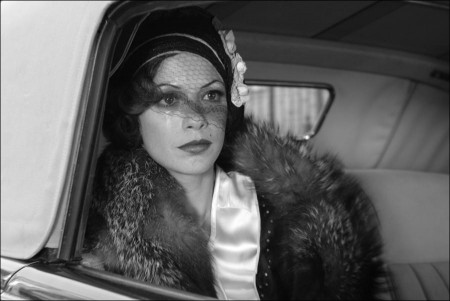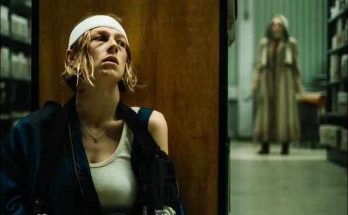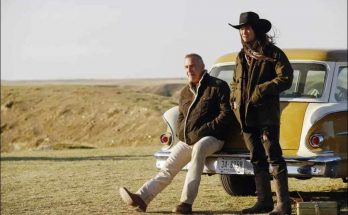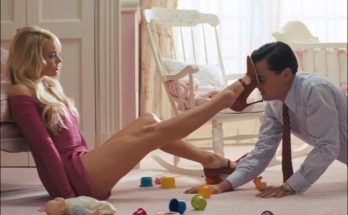“The Artist” is Hazanavicius’s third film with director of photography Guillaume Schiffman, who shot both OSS comedies. “With Guillaume, it’s more than just collaboration,” Hazanavicius remarks. “We’ve done films together, we’ve done ads together, and we know each other very well. As soon as I had the idea of THE ARTIST, I talked to him about it. I gave him tons of films to watch and he did a lot of professional research about the techniques, cameras and lenses of the time. The idea was the same for all us, on both sides of the camera: do some research; nourish ourselves; understand the rules thoroughly in order to be able to forget them at the end.”
Hazanavicius had storyboarded the entire screenplay for THE ARTIST, and during pre-production he and Schiffman spent countless hours looking at these blueprints and discussing their options. In a black and white silent movie, lighting and color scale become critical tools of the storytelling, Schiffman points out. “Because there’s no dialogue, light has to tell you something, the shadows have to tell you something. Michel told me how he envisaged the story, how he was going to play with the blacks and whites, shadow and light, and a lot of grays.
What fascinating about Michel is that he never loses sight of the story he wants to tell. You can’t produce only beautiful images and lose the audience in the process. The goal isn’t to make the audience go ‘Wow!’ at each shot but to captivate them and, in this case, to move them.” Schiffman describes the film as a rare creative opportunity. “A black and white movie; 1.33 format; 20s and 30s style: it’s a dream come true for a cinematographer. What a pleasure to revisit this moment of cinema history, particularly today, when we are moving towards digital supremacy.”
As pre-production got underway in Los Angeles, news of THE ARTIST spread quickly in the film community. The black and white style and period setting offered interesting and unusual work for all the industry’s trades: set design, costume design, hair and makeup, camera, electric, etc. Hazanavicius was delighted to find himself surrounded by some of best and most experienced professionals in Los Angeles, all of them eager to contribute. “Everyone got very excited,” the filmmaker smiles. “I think people appreciated the fact that this was a movie about their profession. People from the camera department offered to make special lenses, old projectors were pulled out of closets … it was very special.”
One of the earliest hires was production designer Laurence Bennett, who has worked extensively with writer/director Paul Haggis on films including the Oscar-winning CRASH. Hazanavicius notes that he had very specific elements he wanted to incorporate into the film’s design, responsibilities that Bennett took on. “THE ARTIST is about the fall of an actor, so I was always looking for locations with stairs. I wanted the actors to go down, and down, and down, sequence after sequence,” says Hazanavicius. “It’s the same with mirrors; it’s the idea of representation because George is an actor. There are always many George Valentins in the frame. Larry brought his own sensibility to the production design, while achieving all the very precise effects I asked him to create. He did a great job.”
Academy Award-nominated costume designer Mark Bridges (THERE WILL BE BLOOD) faced the challenge of dressing the primary cast and between 150-200 extras, who appear as everything from formally attired moviegoers to movie studio personnel. Bridges had grown up going to revival houses to see classic films, including silents like WINGS and Chaplin’s MODERN TIMES, and working on THE ARTIST Bridges studied movies, old publicity stills and day-in-the-life candid photos to get a feel for the impeccable tailoring of the era and the elegant clothing that a movie star like George Valentin would have worn in his leisure time. For the character of Peppy Miller, he found inspiration in early Joan Crawford films, which captures her evolution from average chorus girl to dynamic jazz baby and finally to glamorous star. The silent backstage comedy SHOW PEOPLE provided clues about what studio workers wore, as did a 1925 documentary short made on the MGM lot.
Bridges found both garments and ideas in Hollywood’s professional costume shops, including The Collection at Western Costume, Motion Picture Costume Company, United American Costume Company, and Palace Costume Company. “Here in Hollywood, we’re really set up to do a movie like THE ARTIST. I could go to any of these costume shops I regularly use, go through 100 dresses or 50 dresses, and something would read to me ‘Peppy,’” he says.
Milliners freshened and re-blocked hats that had spent decades in boxes. Vintage shoes were copied, as were some vintage garments that were too fragile or dilapidated to be worn. Some garments were in fine condition and were used in the film, including a nightgown worn by Béjo and a tennis dress Bridges found in a shop. Hazanavicius was impressed by Bridge’s talent and work ethic.
“Mark Bridges knows everything, and I think he works maybe thirty hours a day!” the director enthuses. “He’s very perceptive and he knows that small details can be very powerful. For example, there’s an ellipse from ’29 to ’31, when George’s decline accelerates. I asked Mark to adjust Jean’s costume, and to make it a little bit larger so we have the feeling that his character has shrunken a little bit. And Mark did that, very subtly, with a lot of taste. His work throughout brought so much to the film.”
Music is an indispensable part of silent film storytelling, serving variously as emphasis and counterpoint to the actions and emotions onscreen. For this critical element, Hazanavicius turned to his longtime collaborator Ludovic Bource, who has scored all the director’s films since his feature debut, 1998’s LES AMIS.
Like the other collaborators working on the film, Bource did his homework, listening to scores by legendary Hollywood composers such as Max Steiner, Franz Waxman and Bernard Hermann; music written by Chaplin for his films; and the 19th Century composers whose work was the foundation of Steiner, et al. With that knowledge absorbed, Bource was then free to write the score that would help tell the story of THE ARTIST. He began working on the score before production began, coming up with melodies and themes based on the screenplay and storyboards.
Once production began, Hazanavicius sent him rushes on a regular basis. “I immersed myself in the rushes as they came in, and in the performances of Bérénice and Jean,” Bource remembers. “Watching these magnificent images as they arrived was very inspiring. The hardest thing, particularly with Jean’s character George, was to respect the combination of comedy and emotion. As a result, rather than pastiche or spoof, we worked – a bit like Chaplin – along the lines of a light sophistication. And for the tap dance sequence, I wrote music that was essentially big band / jazz, which was a pleasure.”
Work continued on the film’s music continued during the editing process, when Bource worked with Hazanavicius to refine the music and match it to the final scenes. Bource recorded the score in Brussels with the Flanders Philharmonic Orchestra. Says Bource, “I recorded with 80 musicians: 50 string players, 4 French horns, 4 trombones, 5 percussionists who ran around all over the place, a harpist, 10 technicians, 5 orchestrators, 3 mixers – it was sublime. I was lucky enough to get marvelous people. They told me it had been a long time since they had felt this way while recording the music for a film. It was very moving and gratifying.”
Related Link: Read the Full Production Notes for The Artist
Visits: 113



